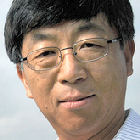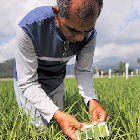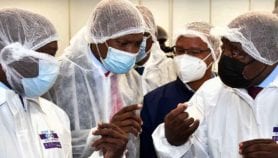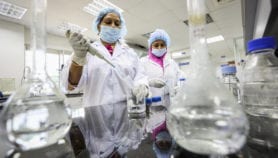By: Yojana Sharma
Send to a friend
The details you provide on this page will not be used to send unsolicited email, and will not be sold to a 3rd party. See privacy policy.
Last week, the world mourned the loss of Norman Borlaug, the agronomist credited with saving as many as a billion people from starvation by introducing high-yield crop varieties.
Borlaug’s success in establishing food security — dubbed the Green Revolution — came at a time when the planet was far less populated than today. When he accepted the Nobel Peace Prize in 1971, one of his many awards, the world’s population was 3.7 billion. By next year, it will reach 7 billion — and Borlaug was among the first to recognise that new strategies will be needed to combat a huge rise in pressure on food resources.
As the tributes to Borlaug continue, one networking organisation that should be pivotal to addressing world hunger is poised to make far-reaching changes to the way it works.
The Consultative Group on International Agricultural Research (CGIAR) has already been the backbone of food security research for the poor. But without radical reform — to link research with its applications; eliminate inefficiency and raise the funding bar — some stakeholders and insiders fear that it might not be fit for purpose.
But its plan for a new way to coordinate agricultural research is not without controversy, calling as it does for a new consortium approach and a central fund, and ‘mega-programmes’ of research and development.
From optimism to challenge
CGIAR — itself founded during the optimism of the Green Revolution in the 1970s — currently has 15 centres in its network, including the International Rice Research Institute in the Philippines and the International Maize and Wheat Research Center in Mexico. More than 3,000 scientists work in the member institutes.
As Ren Wang, director of CGIAR since 2007, comments: "We have done a tremendous job in contributing to global food security and alleviation of poverty. But certainly the centres can do much more to address global challenges."
Those challenges include reversing cuts in funding. Public backing for agricultural research, which had been growing at a rate of 2.7 per cent annually in the 1980s, dropped to 1.1 per cent growth in the following decade.
Meanwhile, good science is increasingly left "sitting in books and research papers" rather than reaching producers and the poor, according to George Rothschild, former director of the International Rice Research Institute, and now chair of the UK Forum for Agricultural Research for Development. Then there are the dramatic and recent effects of climate change.

Wang’s proposals are seen as the most radical of any CGIAR director
Flickr/IRRI
Last year, when food security was pushed to the top of the political agenda, a review found that CGIAR’s centres contributed value but the network overall was "hitting below its weight" and had been "largely absent from the key global debates on the food crisis and climate change".
Roadmap for reform
This summer, a roadmap for reform emerged after months of behind-the-scenes discussions. The key idea is to rally donor funding around so-called ‘mega-programmes’, or development-oriented themes, that address agricultural issues from soil to mouth, rather than pursuing purely scientific programmes.
The proposal requires centres to restructure to work jointly on these mega-programmes, financed from a fund that all donors pay into. This will effectively create the first public international agricultural research fund.
There is also acknowledgement that more money is needed for agricultural research — and that CGIAR must become a more attractive destination for funds. After only recently restoring income to its 1995 level, the organisation now plans to double its income from the current $530 million annual budget for all 15 centres, to US$1 billion.
Under the outline agreed at CGIAR’s annual general meeting in December 2008, centres will retain their identities but work as a consortium to take on the joint, thematic mega-programmes. By working together and presenting a collective face, it should be possible to attract more secure income to a new central fund held by the World Bank.
The reform should reduce inefficiencies such as those at the International Center for Tropical Agriculture in Cali, Colombia, which has an annual budget of US$40 million but runs some 250 small or medium sized projects. "More than half of scientists’ time is spent writing project proposals and reports and not creating knowledge through research," says Wang. "That must change."
Dominated by mega-programmes
Although small and ‘blue sky’ projects will still be possible, Rothschild says that research will become dominated by mega-programmes. These would bring together centres, national institutions, non-governmental organisations (NGOs), social scientists, extension workers and farmer representatives to ensure technology gets to those who need it and in a form that they can use.
"With the mega-programmes, CGIAR is trying to position itself for research for development, not research for its own sake," says Rothschild.
The investment required for such programmes, according to IFPRI, is large for typical agricultural research projects but small compared with general development aid programmes.
The selection and design of the mega-programmes will be pivotal for the CGIAR’s reform. A challenge will be scaling up some of the centres so that they can lead a programme — something each wants to do. "Mega-programmes will have funding of around US$50 million," says Hall. "No single CGIAR research centre currently has a budget of that much."
There is broad agreement that mega-programmes will integrate food, environment and policy issues with the millennium development goals of halving poverty and hunger by 2015. A long list has been drawn up and several programme outlines designed. But the scope, precise goal and number of programmes are still to be decided.
"Mushy hybrid"
Consultations with NGOs and other partners will continue until the end of the year, but ultimately the go-ahead for mega-programmes will mainly be in the hands of donors, as CGIAR centres are totally dependent on their funds.
Some three-quarters of CGIAR funding comes from 12 donors, including the European Union, the World Bank, the United Kingdom and the United States. The larger donors favour the CGIAR consortium and mega-programme approach. But it could more difficult for other donors to contribute to this structure. "Some donors cannot contribute to a central fund because of their domestic regulations — they can only fund specific projects," says Rothschild.
"Bilateral funding is not going to go away," admits Hall. "But what we won’t do is divert our attention towards other things that seem nice but don’t fit."
But Andrew Bennett, closely involved in the talks as chair of the Center for International Forestry Research, a CGIAR organisation in Bogor, Indonesia, sounds a warning. "If you ask CGIAR to think about all the development problems in the world it may lose sight of its real purpose, which is research, and the danger is funding may become more politicised."



Agricultural research faces many challenges, not least the devastating Ug99 wheat rust disease
USDA/Yue Jin
At the development end, meanwhile, Mark Holderness, executive secretary of the Global Forum on Agricultural Research, which is coordinating consultations with NGOs and farmers’ organisations, says: "I am worried that if we don’t get the process right in the wider development sector that we are not going to get the results we want."
"It is all about positioning between basic and applied research," says Christie Peacock, chief executive of FARM-Africa, an NGO. "If you take this [mega-programme] route you could end up with very poor development projects and lousy research. It’s a very mushy hybrid."
There are other potential downfalls. In Africa, the location of four of the CGIAR centres and the recipient of half of CGIAR’s annual budget, institutions are rundown.
"Donors particularly want the CGIAR system to work in Africa. But you cannot put in rocket fuel if you do not have an engine," says Bennett. "There has been a huge decline in research establishments in Africa."
FARA has held extensive consultations with the CGIAR on the reforms, "so that key priorities for Africa are identified and defined. We think to some extent they are listening to us this time," says Jones.
And how will success be judged? If poverty targets are not met, will the research centres get the blame? "We have to ask, are we being asked to achieve an outcome beyond our resources and control?" says Bennett.
The end of a 40-year tradition
As these issues are debated, the reform team is pressing ahead. "Three or four mega-programmes will be defined by March 2010 and vague ideas on another four or five will be fleshed out in the course of next year," says Jonathan Wadsworth, a senior agricultural researcher with the Department for International Development in the United Kingdom, and a member of the reform team.
The central fund will, Wang hopes, be in place by the end of this year, although it could affect cash flows to the centres in the meantime. "It obviously involves a certain amount of risk," says Hall.
Also by December, a consortium board will be appointed, whose first task will be to appoint a chief executive.
Some believe the toughest part will be for the 15 centres to give up their own structures. Says one insider: "We will still have centres with their own culture. You cannot wipe away 40 years of doing things in a particular way."



Some think that scientists could leave CGIAR if the reforms compromise research quality
Flickr/IRRI
Wang admits he does not "have all the answers" on how the consortium will work. But he is more upbeat on the central fund. "This year we did a survey of the 15 largest donors — 14 said they would like to join the fund, although some have conditions." These include effective communication between the centres and other national organisations.
How much donors will actually commit to is hard to predict. "If we get about half the current CGIAR funds, or at least US$250 million for the central fund, we can consider the reform to be a success. If we reach that, it will be very unlikely that the reform will founder," says Wadsworth.
And if that target is not reached, the consortium unravels, or there is infighting over mega-programmes?
"The danger is that five years down the line we will need another reform," says Bennett.
And the victims will be the hungry.













